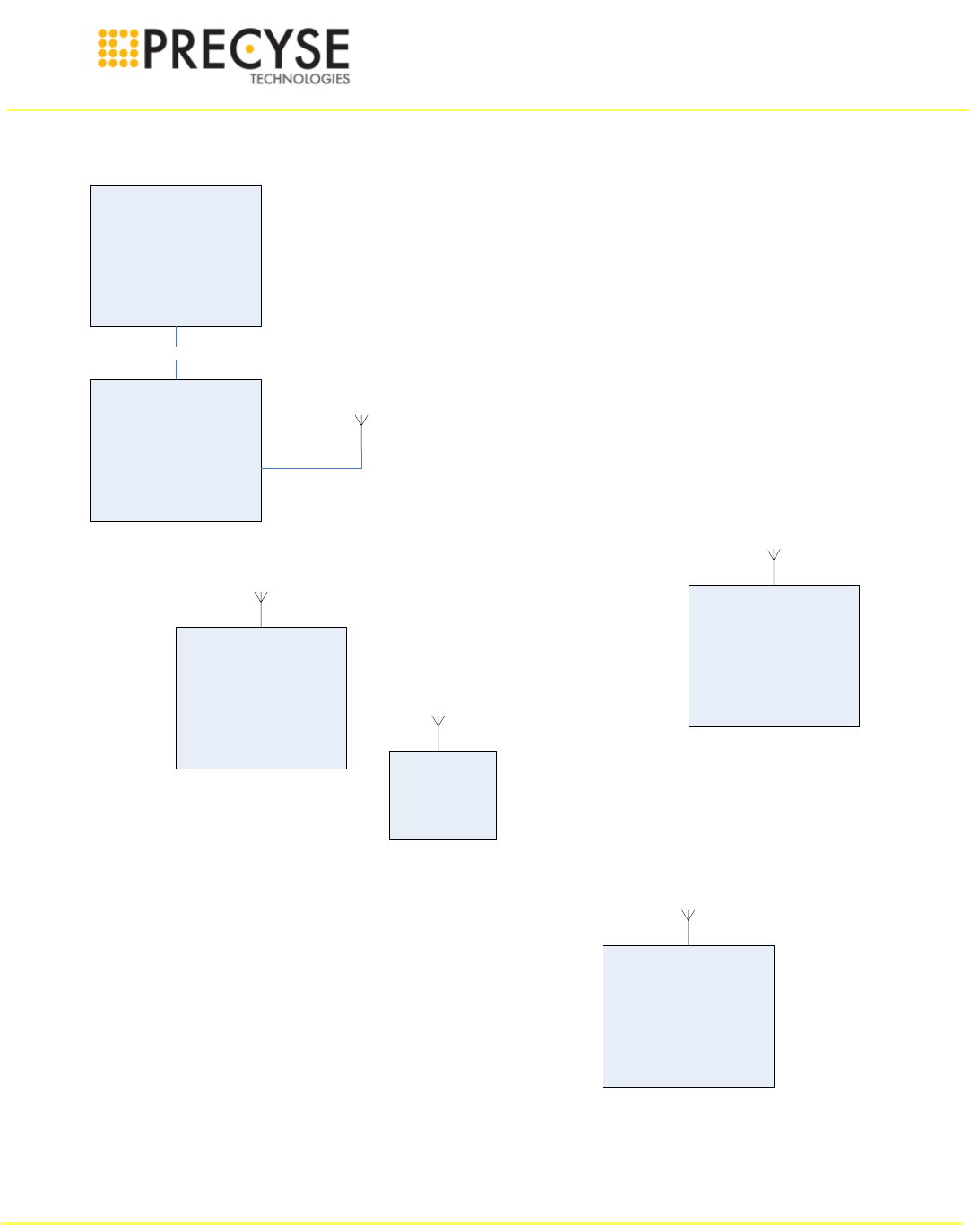Precyse Technologies SA24103000 SA TAG 2.4 GHZ User Manual Technical
Precyse Technologies Inc SA TAG 2.4 GHZ Technical
User Manual

Precyse Technologies, Inc.
Date: 22 May 2012 Page 1 of 10
Precyse Technologies
100 Ashford Center North
Suite 360
Atlanta, GA 30338
Document No. 20110907-1
Revision 1.1
SA tag SA24/103000
User Manual
Release Date: 07/09/2011
Prepared by: Lior Bilia
Distribution (Check all appropriate):
Precyse Only Project Team Only Customer and Supplier

Precyse Technologies
Date: 22 May 2012 Page 2 of 10
Precyse Technologies
100 Ashford Center North
Suite 360
Atlanta, GA 30338
Revision Record
Rev.
Effective
Date
Description
1.0
7/9/2011
1st release
1.1
22/05/2012
Removed block diagram
1.2
Replaced part number to SA24103000
Reference documents
#
Doc #
Description
1

Precyse Technologies
Date: 22 May 2012 Page 3 of 10
Precyse Technologies
100 Ashford Center North
Suite 360
Atlanta, GA 30338
TABLE OF CONTENTS
Section/Title Page
Abstract ................................................................................................................. 4
Regulatory Information/disclaimers ....................................................................... 5
Product description ............................................................................................... 7
SA tag: ............................................................................................................... 7
Technical Data Sheet – SA Tag 2.4 ...................................................................... 7
Compatibility: ............................................................................................... 7
Performance: ................................................................................................ 7
Communication: .......................................................................................... 7
Electrical: ....................................................................................................... 7
Environmental: ............................................................................................ 7
Schematics ........................................................................................................... 8
System test configuration ...................................................................................... 8
SAT .................................................................................................................... 8
Theory of operation ............................................................................................... 8
iLocate system block diagram ............................................................................... 9
Unit definitions: ................................................................................................... 10

Precyse Technologies
Date: 22 May 2012 Page 4 of 10
Precyse Technologies
100 Ashford Center North
Suite 360
Atlanta, GA 30338
Abstract
This document describes the Precyse tag model# SA24/103000 hardware:
1. Micro tag, Precyse part # SA24/103000, referred to as the SA tag.
2. PBC beacon, Precyse part # BC24/403000, referred to as the PBC.
3. PBS base station, Precyse part #BS24/103000, referred to as the PBS.

Precyse Technologies
Date: 22 May 2012 Page 5 of 10
Precyse Technologies
100 Ashford Center North
Suite 360
Atlanta, GA 30338
Regulatory Information/disclaimers
Installation and use of this Wireless Radio device must be in strict accordance with the
instructions included in the user documentation provided with the product. Any changes or
modifications made to this device that are not expressly approved by the manufacturer may
void the user’s authority to operate the equipment. The Manufacturer is not responsible for
any radio or television interference caused by unauthorized modification of this device, of the
substitution or attachment. Manufacturer and its authorized resellers or distributors will
assume no liability for any damage or violation of government regulations arising from failing
to comply with these guidelines.
This equipment has been tested and found to comply with the limits for a Class B digital
device, pursuant to Part 15 of the FCC rules. These limits are designed to provide reasonable
protection against harmful interference in a residential installation. This equipment generates,
uses, and can radiate radio frequency energy and, if not installed and used in accordance with
the instructions, may cause harmful interference to radio communications.
Instructions concerning human exposure to radio frequency electromagnetic fields:
To comply with FCC Section 1.307 (b) (1) for human exposure to radio frequency
electromagnetic fields, implement the following instruction:
A distance of at least 20cm. between the equipment and all persons should be maintained
during the operation of the equipment. The minimum distance will be determined after testing
has been completed.
This document is confidential and proprietary. No part of this document may be reproduced,
stored, or transmitted in any form or by any means without prior written permission from
Precyse technologies Inc.
This device complies with Part 15 of the FCC Rules. Operation is subject to the
following two conditions:
(1) This device may not cause harmful interference and
(2) This device must accept any interference received, including interference
that may cause undesired operation."

Precyse Technologies
Date: 22 May 2012 Page 6 of 10
Precyse Technologies
100 Ashford Center North
Suite 360
Atlanta, GA 30338
The FCC Wants You to Know
This equipment has been tested and found to comply with the limits for a Class B
digital device, pursuant to Part 15 of the FCC rules. These limits are designed to
provide reasonable protection against harmful interference in a residential
installation. This equipment generates, uses and can radiate radio frequency
energy and, if not installed and used in accordance with the instructions, may cause
harmful interference to radio communications. However, there is no guarantee that
interference will not occur in a particular installation. If this equipment does cause
harmful interference to radio or television reception, which can be determined by
turning the equipment off and on, the user is encouraged to try to correct the
interference by one or more of the following measures:
a) Reorient or relocate the receiving antenna.
b) Increase the separation between the equipment and receiver.
c) Connect the equipment to an outlet on a circuit different from that to
which the receiver is connected.
d) Consult the dealer or an experienced radio/TV technician.
FCC Warning
Modifications not expressly approved by the manufacturer could
void the user authority to operate the equipment under FCC
Rules.

Precyse Technologies
Date: 22 May 2012 Page 7 of 10
Precyse Technologies
100 Ashford Center North
Suite 360
Atlanta, GA 30338
Product description
SA tag:
The SAT is used to track assets in real time. It is based on an RF transceiver and a
microcontroller.
It uses the iLocate proprietary protocol which provides a 2 way, half duplex communication with
the base station.
The unit is powered by a 2/3 AA lithium thionyl chloride (Li-SOCl2) battery and is hermetically
sealed with no connectors available to the end user.
Technical Data Sheet – SA Tag 2.4
Compatibility:
SA Tag, 2.45GHz, versions: SA24 / 103000
Performance:
Read range: up to 500 m. (Within line of sight)
Write range: up to 500 m. (Within line of sight)
Read rate: 256 Kbps.
Write rate: 256 Kbps.
Battery size: One 3.6V 2/3 AA Lithium non rechargeable (LI-SOCl2)
Battery life: up to 7 years (depending on application)
Communication:
Frequency: 2405 – 2480 MHz ISM license free band
Modulation: Q-PSK (DSSS)
Channel bandwidth: 5MHz
EIRP: Up to 23 dBm, digitally controlled
Communication protocol: 2WiSAP, optional AES128 Encryption
Transmission: Event base and on demand
External interfaces: Two buttons and an indication LED.
Internal sensors: Accelerometer and temperature sensors.
Electrical:
Power supply: One 3.6 V DC battery, User replaceable.
Environmental:
Size: 55x24x30mm
Operating temperature: -20°C to +85°C (–40°F to +194°F)
Humidity: 90% non-condensing

Precyse Technologies
Date: 22 May 2012 Page 8 of 10
Precyse Technologies
100 Ashford Center North
Suite 360
Atlanta, GA 30338
Enclosure: TBD
Weight: 38g (1.5 ounce)
Schematics
Will be provided on demand and under confidential agreement (not for public use)
System test configuration
SAT
The unit tested was configured with all hardware options present (Motion sensor M1 and keypad
connectors J2 and J3).
Since the unit, under its normal operation, does not transmit data periodically, for emissions
measurements, the SAT was programmed with a special test software to transmit packets
continuously at maximum output power, maximum duty cycle (20%) with power amplifier enabled.
Normal duty cycle, assuming worst case, one event per second is 0.5% (5msec transmit time per
1 second).
Theory of operation
The SAT method of communication is synchronized event based reporting, the SAT spends most
of its time in low power sleep mode. When an event happens, the SAT sends a report to the base
station. In order to avoid packet collisions and associated detection methods, the system uses a
synchronous protocol, that is, An SAT can transmit data only after receiving a synchronization
signal from the base station.

Precyse Technologies
Date: 22 May 2012 Page 9 of 10
Precyse Technologies
100 Ashford Center North
Suite 360
Atlanta, GA 30338
iLocate system block diagram
PC
PBS
TAG (SAT)
Attached to
assets
Ethernet
PBC1
PBC2
PBC3

Precyse Technologies
Date: 22 May 2012 Page 10 of 10
Precyse Technologies
100 Ashford Center North
Suite 360
Atlanta, GA 30338
Unit definitions:
Base station, referred to as PBS: A radio device that transmits data to and from the tag (SAT) to a
personal computer (PC), also provides synchronization signal. The unit is powered by a DC power
supply.
Beacon, referred to as PBC: A radio device that defines a location. Location detection can be
realized through one or more PBCs. The unit is powered by a DC power supply.
Tag (SAT): A radio device that is used to track and monitor assets. It communicates with the PBS
and can detect the PBC signals.